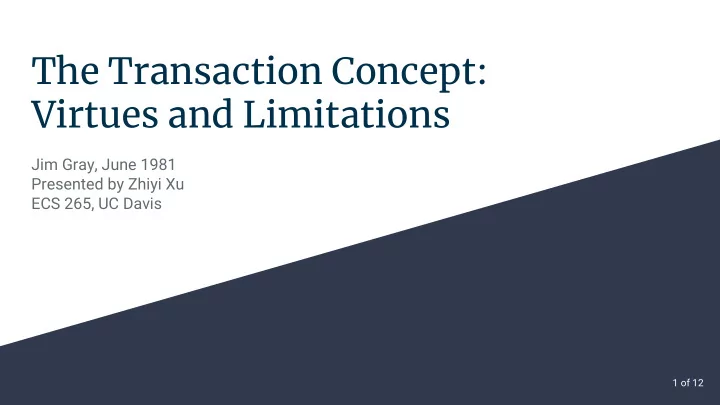

The Transaction Concept: Virtues and Limitations Jim Gray, June 1981 Presented by Zhiyi Xu ECS 265, UC Davis 1 of 12
Overview Part 1: ● What is Transaction? ● A General Model Part 2: ● NonStop ● Time-Domain Addressing ● Loggin and Locking Part 3: ● Limitations of Known Techniques 2 of 12
What is Transaction? Examples ● Contract Law ● Agreement ● “Christian Wedding Ceremony” Component ● Negotiation ● Binding ● Intermediary Properties ● Consistency ● Atomicity ● Durability 3 of 12
A General Model “Transformations of a system state.” Multiple actions can be done during transaction: ● Unprotected (no need to undone or redone) ● Protected (can or must be undone or redone) ● Real (once done, cannot be undone) Outcomes of transaction: ● Committed ● Aborted Types of Transaction: ● Simple (linear sequence of actions) ● Complex (concurrency, dependence, nested) 4 of 12
NonStop No Perfect System and Other errors. Unreliable (does wrong) and Unavailable (does not do right within time limited) Solution (fault-tolerant application): ● Checkpoint and backup process ● Initial transaction state Implementation of fault-tolerant applications: ● Time-domain addressing ● Logging plus locking 5 of 12
Time-Domain Addressing <name, time> ● The old value continues to exist ● Can be addressed by specifying time interval E: <V0, [T0, T1)>, <V1, [T1, T2)>, V2, <T2, *)> ● Most complete proposal for transaction system by Dave Reed ● Aborted if T2 >= T3 ● Depending on commit record Problems: ● Reads are writes ● Waits are aborts ● Timestamps force a single granularity ● Real operations and pseudo-time 6 of 12
Logging and Locking All the undoable actions and redoable actions must have log records Log records should be kept in stable storage for possible reconstruction Sample log record: ● Name of transaction ● Previous log record of this transaction ● Next log record of this transaction ● Time ● Type of operation ● Object of operation ● Old value ● New value 7 of 12
Logging and Locking (cont.) 8 of 12
Logging and Locking (cont.) Other Details: ● Unprotected actions do not need log record. ● Real actions must be deferred until commit. Implemented by applying redo log. ● Undo and redo operations must be restartable. Atomicity: ● Transaction that contributed to multiple logs. ● Multiple participants in one transaction (Ex: Wedding). Concurrent transactions: ● Can read Input, but must not read or write output. ● Lock an object when it is accessed. ○ Lock confliction (predicate that covers the records). ○ Deadlock (Timeout or cycle detection). 9 of 12
Limitations of Known Techniques Transactions cannot be nested inside transactions. Transactions are assumed to last minutes rather than weeks. Transactions are not unified with programming language. 10 of 12
Travel Agent Example Nested transactions ● Might be undone by invoking compensating transaction. ● Visible effects to the outside world prior to the commit of parent transaction. Long-lived transactions ● Concurrent transactions and deadlock. ○ Only active transactions hold locks. ○ UNDO and REDO commute with DO. ● Abortion when system restarts ○ Save point declaration. 11 of 12
Thank you! Q&A 12 of 12
Recommend
More recommend